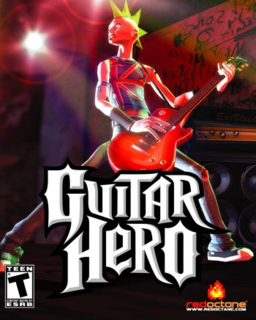Groupies Sold Seperately
Two years later, “Amplitude” was released. Little of the game’s core mechanics was changed. Other than an increased overall difficulty and a vastly sleeker design, the major change that was made was the inclusion of more mainstream music acts, if not entirely comprised of mainstream acts. While most of these songs proved to be quite fun to play and challenging (which is really the only compliment I can give to such artists as “Pink”, “Papa Roach” and “Blink 182”) some songs simply were not too fun to play (Weezer’s “Dope Nose”; Baldwin Brothers “Urban Tumbleweed”), did not really fit the game or tone of the game (Weezer’s “Dope Nose”; Garbage “Cherry Lips”; Slipknot “I Am Hated”) or were simply bad songs that were uninteresting on their own right, outside of the gaming realm (…..did I mention Weezer, yet?). This originally alienated the electronica fans that wanted more of the same music (although, to be fair, the game still did have a major electronica influence; it just went untouched in promotion). The game was still a rhythm game at heart; thus, it still did not sell well.
Despite lackluster sales and a niche audience, Harmonix still plugged away at making music games; the “Karaoke Revolution” series being the developer’s other noteworthy series of games. Last November, Harmonix released another PS2 game based on the “Frequency/Amplitude” mold: Guitar Hero. As you can see in the picture, the game differed from the previous two games in a major and critical way: a replica of a SG Gibson Guitar as the controller. Initially this appears to be a cheap gimmick utilizing a cheap toy to push product. But for most people I know that have played the game, it only takes about two songs before the game hooks onto the player and “clicks”. Will the game help you learn how to play guitar or even make you a better guitar player? No. But that is not the point; the appeal being the sheer comedy factor and entertainment of playing “air guitar” in a more impressive fashion. The guitar uses five “fret buttons” instead of strings. Hold down the button that corresponds with the oncoming note, then strum down on the strummer to play; simple concept indeed. Throw in a large number of notes, the ability to “hammer on” and “pull off” notes, playing chords, a whammy bar (for the sound effects whore in all of us), the ability to activate a multiplier/life-saver by tilting the guitar vertically (circa 80’s hair metal), and arguably the best licensed-song based soundtrack for a music game to date and it is clear that this game was not taken lightly. Most impressive to those that played the previous two games in the “Guitar Freqtude” series is how in this game, the overall goals and achievements are the exact same as the previous two, only now the game is significantly more involving and engaging; pass a song first just to unlock other songs, then go back to play the song to get higher scores and more money to unlock items/songs. Further proof that this game was taken seriously is the soundtrack. It goes without saying that a music game with terrible songs is about the equivalent of watching a television show or movie with unbearable picture quality. Outside of a list of guitar-oriented classic rock songs to more current rock songs that ranges from Black Sabbath to Franz Ferdinand, arguably the most amazing quality of the game is how wonderfully the songs were translated to the game. All thirty of the mainstream songs in the games are covers, but outside of some vocal miscues in a few songs (such as “Symphony of Destruction” by Megadeath and “Stellar” by Incubus) it is almost impossible to notice that every instrument in the game was re-recorded for the game. Just for the parties alone, this game could prove to be a real treat, and if you want to consider dabbling into the music gaming genre, it would be wise to start here.

